NAD+ Precursors and Healthy Aging
Nicotinamide adenine dinucleotide (NAD+) is a coenzyme found in all living cells. It is a critical coenzyme for energy metabolism and also serves as the substrate for enzymes such as the sirtuins. One of the hallmarks of aging is declining cellular NAD+ levels. Moreover, many studies carried out in different organisms have shown that modulation of NAD+ production, as well as supplementation of NAD+ precursors can prolong both healthspan (i.e., the lifespan without disease) and lifespan.
Nicotinamide riboside (NR) and nicotinamide mononucleotide (NMN) are both well-known NAD+ precursors that can effectively increase NAD+ levels across multiple tissues. They are very similar to each other. In fact, they are only one reaction away: in cells, NR can be transformed into NMN by NR kinases (NRKs). Since NRK is the rate-limiting enzyme during this reaction and NMN can be directly converted into NAD+, NMN is considered a theoretically better NAD+ precursor than NR.
However, in a recent paper, the reduced form of NMN, known as NMNH, is shown to be a more potent NAD+ precursor compared to NMN.
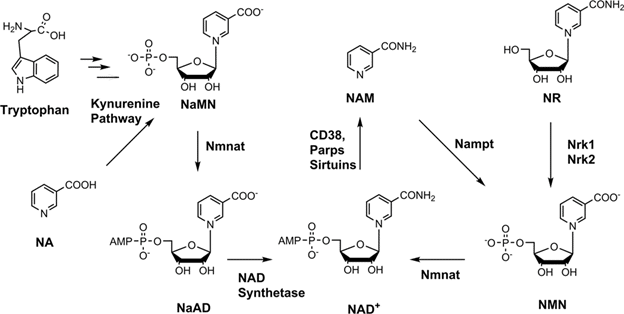
A Story Begins with NR and NRH
Although NMNH sounds like a new thing to most people, even to people familiar with NMN and NAD+ precursors, it is not entirely new. Before we look into NMNH, let’s first go back to 2019 and talk about NR and the reduced form of NR (NRH).
In 2019, Giroud-Gerbetant et al. showed that the reduced form of NR is a more potent NAD+ precursor compared to NR.
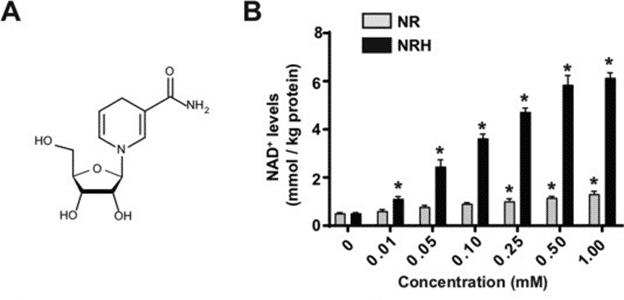
NRH but not NR Increases Cellular NMNH Levels
NRH can induce significantly higher cellular NAD+ levels compared to NR. Besides this, what is interesting is that NRH also induces increased levels of cellular NMN and NMNH, which is not achieved by NR.
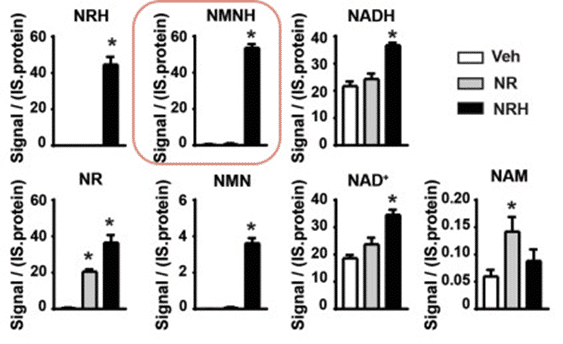
But how? Note that in 2019, we didn’t know how NRH works and why it increases NMNH levels. Up until 2020, other research showed that NRH can be transformed into NMNH by NRH kinase (AK). This step is necessary as when AK is abolished, NRH fails to increase cellular NAD+ levels. This new route for NAD+ biosynthesis is called the NRH salvage pathway.
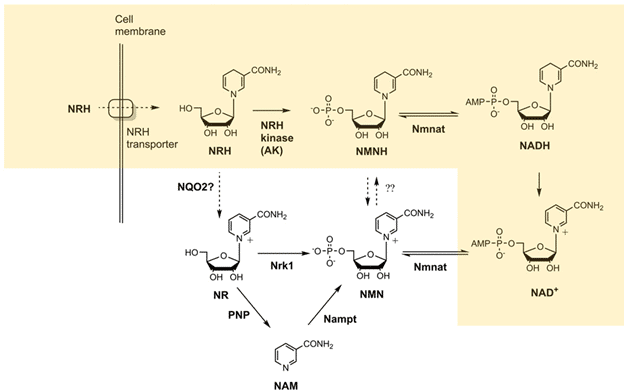
NMNH is More Potent than NMN
From here, you may notice that the relationship between NR and NMN is extremely similar to the relationship between NRH and NMNH. Since NRH is a more potent NAD+ precursor compared to NR, is NMNH also better than NMN?
The answer from this new research in 2021 is yes. According to the data from Zapata-Pérez et al., when applied to cultured cells, the NMNH is shown to be more efficient than NMN as it was able to “significantly increase NAD+ at a ten times lower concentration (5 µM) than that needed for NMN”. Moreover, NMNH shows to be more effective, as at 500 µM concentration, it achieved “an almost 10- fold increase in the NAD+ concentration, while NMN was only able to double NAD+ content in these cells, even at 1 mM concentration.”.
Interestingly, NMNH also appears to act quicker and have a longer-lasting effect compared to NMN. According to the authors, NMNH induces a “significant increase in NAD+ levels within 15 minutes”, and “NAD+ steadily increased for up to 6 hours and remained stable for 24 hours, while NMN reached its plateau after only 1 hour, most likely because the NMN recycling pathways to NAD+ had already become saturated.”.

NMNH shows a Similar Metabolic Effect as NRH
As we discussed previously, NRH but not NR supplementation can induce the increase of NMN and NMNH. Interestingly, supplementation of NMNH shows a very similar pattern. The supplementation of NMNH could induce a significant rise of NR and NRH in the cell, while NMN cannot. This result provides a piece of further evidence that supports NMNH as a better NAD+ precursor compared to NMN and NR.
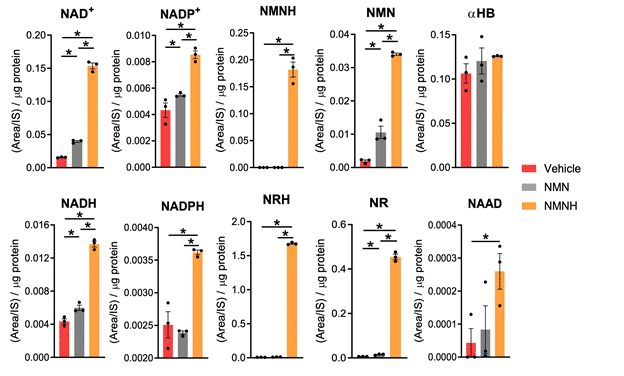
NMNH Provides a More Robust Increase of NAD+ Levels in Mice
Previous studies were carried out in cultured cells (i.e., in vitro). So does NMNH also work in a real animal?
To address this, researchers performed an IP injection of 250 mg/kg NMN(H) in mice and after 20 hours, a second injection was administered at the same concentration. Strikingly, while blood NAD+ content after NMN supplementation declined to basal levels after just 4 hours, NMNH administration sustained a 2-fold NAD+ increase for at least 20 hours following the first injection. This was also reflected in the blood samples taken 4 hours after the second IP injection, as an increase in NAD+ was only detected in NMNH-treated animals.
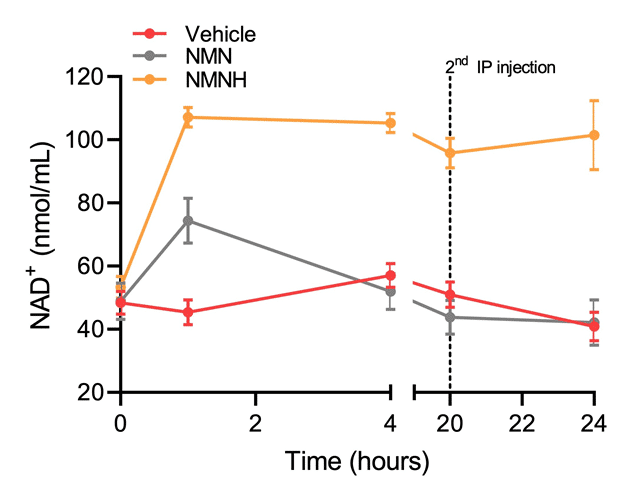
NMNH increased NAD+ levels in more tissues
Moreover, NMNH increased NAD+ levels in a variety of tissues and to a greater extent than NMN, with the most remarkable effects in the liver (>5-fold increase) and kidney (>2-fold increase). NMNH also significantly increased NAD+ content in other tissues, such as the brain, gastrocnemius muscle, brown adipose tissue, and heart, while NMN failed to do so.

Summary
Together, these results demonstrate that NMNH is an efficient NAD+ booster that can increase NAD+ levels to a greater extent than NMN in various tissues. NMNH is established as the second member of the new family of reduced NAD+ precursors, besides NRH. This new data, together with previous findings, indicate that reduced NAD+ precursors can act as very potent NAD+ enhancers and open doors for a new generation of highly efficient NAD+-boosting molecules.
Read the research article here:
https://faseb.onlinelibrary.wiley.com/doi/full/10.1096/fj.202001826R
